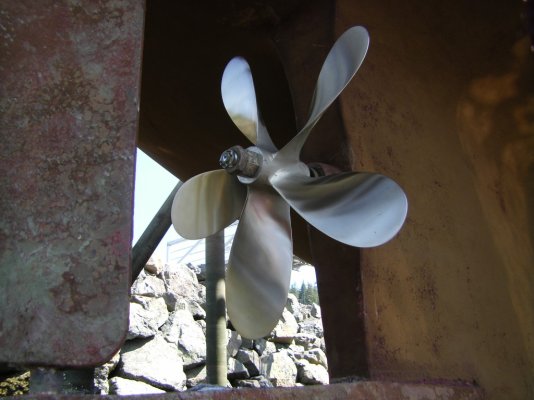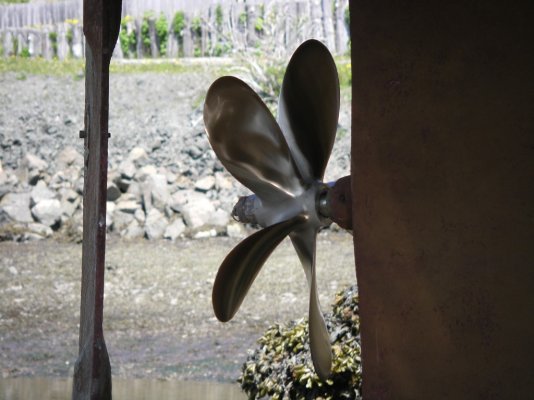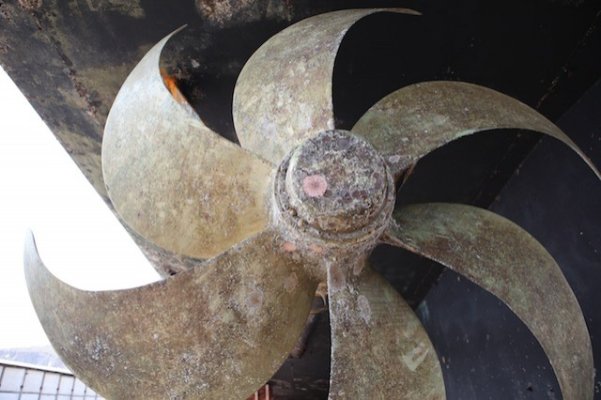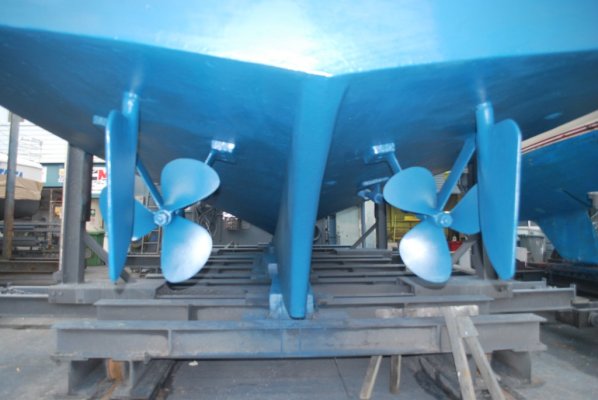So how do you all determine your best prop configuration? *Our 36 Monk with single Perkins 6.534 135hp has a 4 blade, 24 LH 18 prop on the boat currently. *Seller also gave me 2 additional props with the boat when I bought her- a second 24 LH 18 with 4 blades as well as a 24 LH 19 with only 3 blades. *I don't know how much difference one would see in a boat only going 7-8 knots beyond the fact that the 4 blade probably gives you more bite into the water than the 3 blade but thought I'd see how you all determine which props are best to use for your set up.
You are using an out of date browser. It may not display this or other websites correctly.
You should upgrade or use an alternative browser.
You should upgrade or use an alternative browser.
How to determine best prop configuration?
- Thread starter Woodsong
- Start date
The friendliest place on the web for anyone who enjoys boating.
If you have answers, please help by responding to the unanswered posts.
If you have answers, please help by responding to the unanswered posts.
When we were told by Prop Shop "X" that the existing props on our GB36 were "worn out" we didn't do anything about it for another two years and then on our next haulout decided to go ahead and get new props.* I asked a number of people I knew who had had prop work done as well as friends in the local marine engine business who they felt the best prop shop in Seattle was.* They all gave me the same answer (it wasn't Prop Shop "X"), so I called them to find out what they needed to know to figure out the best props for our boat.Woodsong wrote:
So how do you all determine your best prop configuration?
They wanted the following information:
Make and model of the boat.
Make and model of the engine(s).
The maximum rated horsepower of the engine(s) and the rpm at which this power was achieved.
The rpm we got at wide-open-throttle with the props we had on the boat.
The number of blades we wanted the new props to be (we had decided to switch from four-blade to three-blade)
And they wanted us to bring in the old props.
I also told them what the diameter and pitches had been of the props fitted by the manufacturer although these props were no longer on the boat.* But I thought the information might be helpful.
As it turned out they saiid that our existing props were not worn out but they had been horribly set up by whoever did it last (which would have been in the San Francisco Bay area prior to our buyng the boat).* Part of one blade wasn't even moving water, the pitches of the blades were slightly different, and so on.
So they overhauled our existing Michigan props.* Based on the numbers I had given them they repitched the props from 17" and 18" down to 16" each and after truing the blades the prop diameters were 23."* Had we decided to switch to new three-bladed props anyway, the pitches would have been different (one inch more in our case).
The point is that we used a good, reputable prop shop to determine the optimum configuration of our props based on the information we gave them.* Also, this shop has done props for dozens if not hundreds of GBs over the years so it was not a boat they were unfamiliar with.* I have no idea what sort of calculations or forumulas they used to arrive at what they arrived at.* I'm sure if one got hold of the formulas one could do the calculations themselves.* But based on our experience, my advice would be to use a good prop shop in your area to figure out what the best prop configuration for your boat would be.
*
Regarding three blades vs four blades, this is what we were told by the prop shop and our friends in the marine engine business:
The fewer the blades a prop has the more efficient it will be.* The most efficient prop would have one blade but it'd be a bitch to balance
A three-bladed prop is more efficient than a four-bladed prop (assuming the same size prop).* A three-bladed prop will back better than a four-bladed prop, which means there is less prop walk with a three-bladed prop than a four-bladed prop.* Less prop walk can be an advantage in a single engine boat but (in my opinion) is a disadvantage in a twin engine boat.
A four-bladed prop will be smoother than a three-bladed prop, so if a boat has a vibration problem that's not caused by something else like bad shaft alighnment, etc. switching to a four or even five bladed prop might help.
According to our boat's original owners manual, it was originally fitted with three-bladed props of 17" and 18" pitches, 24" diameter.* These props were overpitched for the boat but this was typical for GB when they were using engines like the FL120.* Since boat speeds and cruise power levels were low in those days, overpitching the props gave a bit more speed for the power developed but was not hard on the engine(s).
The prop shop told us that four bladed props are typically pitched one inch less than a three-bladed prop for the same engine(s) and boat.
Don't know if any of this is relevant to what you are trying to find out, but it was our experience with dealing with the props on our boat.
-- Edited by Marin on Sunday 10th of October 2010 10:10:29 PM
Woodsong
Guru
Very interesting- thanks so much for posting! Especially interesting is the comment on less prop walk for 3 blade vs. 4 blade. I've got some serious prop walk when in reverse...stern pulls to starboard very hard...like it just wants to do donuts in the water.  Less prop walk would be great.
Less prop walk would be great.
FF
Guru
- Joined
- Oct 12, 2007
- Messages
- 22,552
Dave Gerr's other books: Propeller Handbook ...
www.gerrmarine.com/books.html -
From Goggle. Great if you want to understand and optomise, really useful for noodeling a Cruising Prop.
The most "efficient " prop would have the fewest number of blades.
Aircraft used a single blade and counterweight , but on a motor boat , the diameter of even a 2 blade would be too high.
However many sailboats CAN carry a 2 blade , that's why they can sometimes get 10mpg .
The largest diameter slowest turning prop with fewest blades is usually the efficiency choice.
HIGH Speed is a different matter , its all about rapidly dumping HP into the water , so 4 and 5 blade setups are used , but may produce great speeds at 1/2 a mile per gallon and less.
www.gerrmarine.com/books.html -
From Goggle. Great if you want to understand and optomise, really useful for noodeling a Cruising Prop.
The most "efficient " prop would have the fewest number of blades.
Aircraft used a single blade and counterweight , but on a motor boat , the diameter of even a 2 blade would be too high.
However many sailboats CAN carry a 2 blade , that's why they can sometimes get 10mpg .
The largest diameter slowest turning prop with fewest blades is usually the efficiency choice.
HIGH Speed is a different matter , its all about rapidly dumping HP into the water , so 4 and 5 blade setups are used , but may produce great speeds at 1/2 a mile per gallon and less.
Nomad Willy
Guru
As to the smoothness issue I think the width of the blade tips will have more effect on smoothness than number of blades. With a 4 blade prop one has 50% of the total blade in the keel shadow and it's turbulence while the 3 blade has only 33%. The only good reason to employ a 4 blade prop is if a 3 blade won't have enough blade area to deal with the power of the boat. On a heavily loaded prop the pitch/dia ratio may become undesireable as in too much pitch. A four blade with an efficient pitch/dia ratio will/may be more efficient than a 3 blade. I tried a 5 blade on my Willy and the pointy blade tips (I think that was the reason) caused a higher frequency vibration ....my 3 blade was smoother. I suspect that the smoothest props may be those scimitar like props, as in highly skewed blades. I know the quietest propeller blades on an airplane and a submarine are heavily skewed and I'll bet quietness and vibration are highly connected. Another theory of mine is that lower pitch propellers generally develop less vibration. So in my opinion a large lightly loaded propeller w wide blade tips and low pitch should be the smoothest.
Attachments
RickB
Guru
- Joined
- Oct 20, 2007
- Messages
- 3,804
- Vessel Make
- CHB 48 Zodiac YL 4.2
nomadwilly wrote:
I suspect that the smoothest props may be those scimitar like props, as in highly skewed blades.
Like this one?* They all vibrate and make noise sooner or later.
*
*
Attachments
Carey
Guru
- Joined
- Oct 5, 2007
- Messages
- 1,101
- Location
- USA
- Vessel Name
- Happy Destiny
- Vessel Make
- Custom Lobster Yacht
I don't claim to understand all the nuances of prop design, but one thing I learned from the manufacturer of my boat when I repowered, is that more blades are better as you get closer to the hull. In my repower, I was increasing horsepower, which led to a larger diameter prop. As I was now closing in on the hull with a two inch larger diameter, it was recommended that I go with five blades instead of four in order to avoid cavitation. It worked. It truly is a smooth prop. Kinda reminds me of a submarine prop.Carey
Tom.B
Moderator Emeritus
- Joined
- Jul 30, 2009
- Messages
- 5,839
- Location
- USA
- Vessel Name
- Skinny Dippin'
- Vessel Make
- Navigator 4200 Classic
Let me know if you want to sell the 24/18 prop. Any idea who manufactured it?
I currently have the same motor and a 24/17 4-blade prop that was repitched by the PO. HIS previous owner (two ago for me) had change it to 19 or 20 thinking he'd get more speed, but didn't. So it was put back to 17. The stock is 18.
One other note: Prop walk is not a bad thing. Don't be afraid of it. Embrace it. Use it to your advantage because there are lots of good things about it.
I currently have the same motor and a 24/17 4-blade prop that was repitched by the PO. HIS previous owner (two ago for me) had change it to 19 or 20 thinking he'd get more speed, but didn't. So it was put back to 17. The stock is 18.
One other note: Prop walk is not a bad thing. Don't be afraid of it. Embrace it. Use it to your advantage because there are lots of good things about it.
hollywood8118
Guru
- Joined
- Nov 16, 2009
- Messages
- 2,381
- Location
- USA
- Vessel Name
- " OTTER "
- Vessel Make
- Ocean Alexander Europa 40
I believe the idea that prop walk is a bad thing comes from sailboats.... It isn't uncommon for a lot of sailboats to walk to the side so quick that its hard to back out of the slip.
One other note: Prop walk is not a bad thing. Don't be afraid of it. Embrace it. Use it to your advantage because there are lots of good things about it.
I consider the prop walk to be my stern thruster!, although my walk goes away completely when the boat gets to about 1 kt
*
FF
Guru
- Joined
- Oct 12, 2007
- Messages
- 22,552
It isn't uncommon for a lot of sailboats to walk to the side so quick that its hard to back out of the slip.
Maybe the fin keel nothing in the underbody racers , but most cruising sailors will have a long keel for the stability under self steering the ability to go in shallow water , and to take the ground.l
Our 90/90 is 4 ft draft on a LWL of 28 ,18000 lbs
our Benateau First 32 is almost 6ft in 8800 lbs
Maybe the fin keel nothing in the underbody racers , but most cruising sailors will have a long keel for the stability under self steering the ability to go in shallow water , and to take the ground.l
Our 90/90 is 4 ft draft on a LWL of 28 ,18000 lbs
our Benateau First 32 is almost 6ft in 8800 lbs
Andy G
Hospitality Officer
- Joined
- Sep 20, 2010
- Messages
- 1,897
- Location
- Australia
- Vessel Name
- Sarawana
- Vessel Make
- IG 36 Quad Cabin
This is the configuration on our present boat.It produces a lot more prop wash and noise while underway than my old single screw boat, no noticable vibration though.*Both boats have Ford Lehman 120hp engines. I am wondering is this increased wash noise/turbulence is*just a factor of having two engines instead of one.We cruise on about 1750-1800rpm




